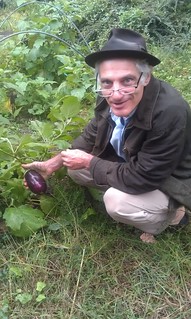During a recent dinner at the temple of the International Society for Krishna Consciousness, at 25 First Avenue, a middle-aged man outfitted as Jesus, complete with crown of thorns, zealously preached the virtues of homegrown produce. In between bites of a spicy lentil salad, Laksmi Nrsimha, director of the East Village branch of the Krishnas, tilted his shaved head to listen.
Among Mr. Nrsimha’s guests at the weekly pay-what-you-wish dinner were volunteers at Village Green, an urban grange somewhat unbelievably located smack in the crossroads of Seventh Avenue and West 12th Street. For the last year, more than a dozen unpaid gardening enthusiasts have been providing a solid supply of free homegrown fruits and vegetables to the Krishnas, who cook them and distribute them at the sliding-scale dinners as well as at food lines in Tompkins Square Park.
But that arrangement has come to an end: this week Village Green closed so that its landlord, Rudin Management, could replace it with a more traditional public green space. Now Mr. Nrsimha is contemplating hydroponic gardening on the temple’s roof.
Gary Rissman, the 53-year-old dressed as Jesus (it was Halloween-time, after all), was the first of the agronomists to hear about the Krishna meals. At a Freegan meet-up early last year, he heard mention of the Krishna’s Annual Mountain of Food Festival, put on by their Krsma-Bhakti Vegan Cooking Club.
At that event, held at NYU’s Kimmel Center, the self-described “free-thinker” was inspired by the Krishnas’ culinary prowess, and saw it as a continuation of his own work. “I died a little inside when I saw our Village Green harvest when dropped off at other shelters, all going into one pot without any love,” he said at last month’s dinner. “An eggplant should be treated like filet mignon. I saw instantly that the Krishnas would know what to do with vegetables, that they would respect the vegetables, cook them right.”
Mr. Rissman, a gregarious speed-talker, convinced his farming pals to begin donating their harvests to Mr. Nrsimha and his fellow Krishnas.
Laksmi Nrsimha is the Sanskrit name for Larry Pugliese. The 62-year-old looks more than a little like Larry David, and he is so good-natured and pop-culture savvy (he’s a Facebook fan of “The Colbert Report” and “The Office”) that you get the sense he would chuckle at the comparison.
An Italian American from Newark, he joined the church in 1972. He’s often credited by rock historians for nurturing the Krishnacore punk rock movement of bands that follow Krishna teachings (e.g. the Cro-Mags and Cause for Alarm). He is equally at home with the classics, and as a literature major at Albright College in Redding, Pennsylvania, his go-to reads were the American Transcendentalists, especially the original quirky gardener, Henry David Thoreau.
“I often quote Thoreau in Krishna meetings,” he confessed to the guests at the table.
By far the quietest invitee was John Cannizzo, 57, a non-Krishna-devotee who currently directs the Horticultural Society of New York’s GreenTeam Projects and installs innovative gardens all over the city – at schools, assisted living residences, public spaces and even hospitals. The East Village resident sported the rumpled jeans and t-shirt of someone who is comfortable working in the field (as a Peace Corps volunteer, he helped Kenyan herders and farmers build rainwater-harvesting water tanks).
These days, Mr. Cannizzo helps ex-offenders and those with special needs develop marketable skills as gardeners. During a recent visit to Village Green, he worked alongside Jon Rauscher, a 64-year-old Vietnam vet and former low-risk Rikers Island inmate who regularly travels from his home in Rockaway Beach to volunteer at the garden.
“People change when they come into contact with gardening,” said Mr. Cannizzo. “Some of my trainees have social disabilities. The work has been like a therapy, a source of pride to the gardeners.” He lowered his bifocals as he spied an unexpected eggplant growing out of a manhole cover. “Can you believe this truant? Eggplant seed must have gotten in there, and there was just enough soil.”
Mr. Cannizzo went on to point out an Edenic apple tree growing along a trellis near Seventh Avenue. It was planted in 2007, when the Horticultural Society of New York redesigned Village Green — then a horticultural therapy center for AIDS patients – as a biblical garden.
The oddly-shaped block didn’t always house a garden. In 1929, it was the brand-new site of the largest movie palace below 14th Street, immortalized in a 1937 Edward Hopper painting, “Sheridan Theater.” After the theater was padlocked and demolished in 1969, it was replaced by a storage facility for medical supplies – hence the spooky abandoned tunnel, vault and X-ray rooms still found under street level today.
The storage facility was razed in the 1980s, and up went Village Green; but with the ongoing downsizing of St. Vincent’s hospital, followed by its bankruptcy in 2010, the AIDS patients began to take their treatment uptown at Beth Israel. The remaining gardeners decided not to be bound by what was mentioned in the Bible and planted whatever might reasonably grow in Greenwich Village.
When the Rudin Management Company purchased St. Vincent’s Medical Center holdings out from bankruptcy in late 2011, the powerful real estate and Hollywood film family firm also inherited the hidden yet fully operational fruit-and-vegetable farm. Community Board 2 had voted to support the Rudins’ plan to replace St. Vincent’s with a 21-story residential building, but only with a number of stipulations attached, including expanded community use of Village Green.
Back in the garden, Mr. Cannizzo pointed out crabapple and Russian Olive trees. “Russian Olive is the only olive tree that would grow in the middle of Greenwich Village,” he said.
When the volunteers in Village Green decided to not be constrained by Old Testament and scriptural references, the harvest expanded considerably. Mr. Cannizzo mentioned eggplant, carrots, broccoli, beans, tomatoes, salad greens, and red pepper, basil… “Mountain mint,” Mr. Rauscher added, popping tomatoes in the buckets that would later be driven to the Krishna temple for the very last time.
In the chill of November, the lettuces were all that was left, but the two farmers happily grabbed the last of them. They put away the tools in the gardening shed for the final time, and then Mr. Cannizzo locked the gate. Outside, he sighed and smiled, happy to have been part of a remarkable run.
Although he adamantly has no plans to become a Hare Krishna convert, he genuinely likes how the Krishnas treat the underprivileged, and hoped his new friend would follow through on his rooftop gardening dream. “For those groups that are lucky enough to have the right kind of concrete and steel structure, rooftop farming can be an enormous benefit and is completely feasible,” he said. “I think it will be terrific for the Krishnas, and terrific for the truly needy in the East Village.”






